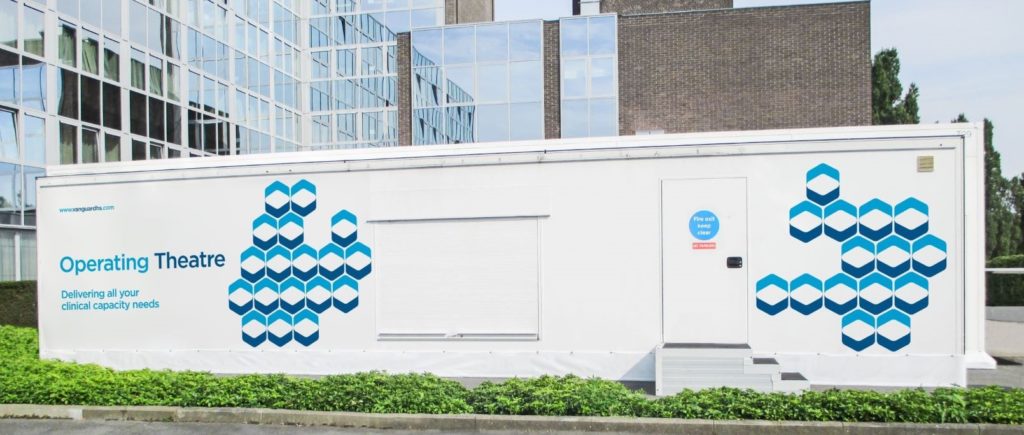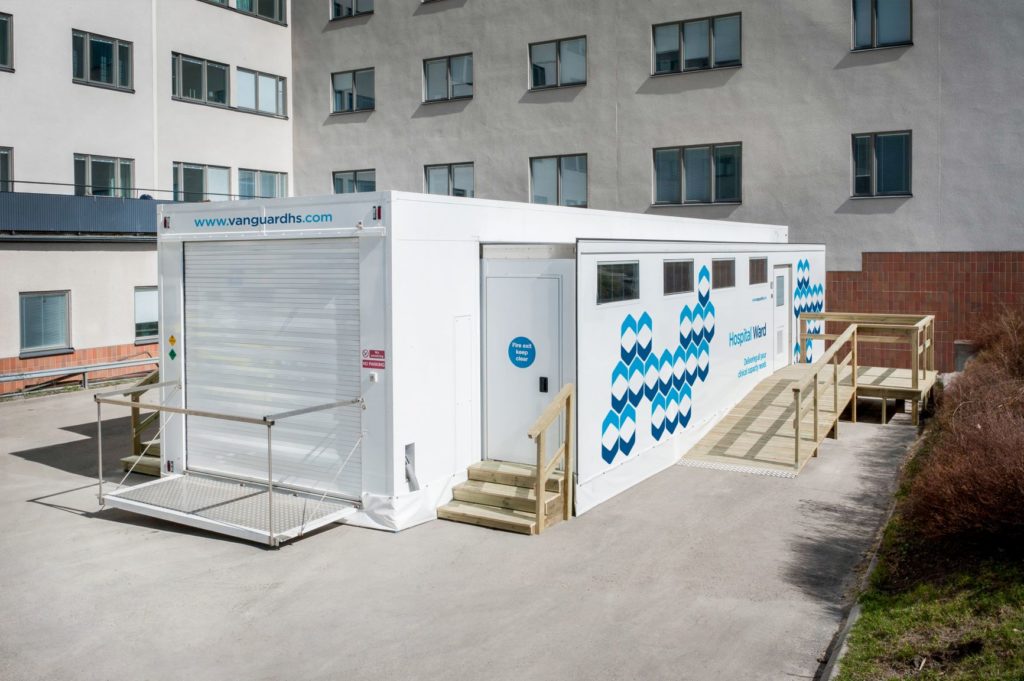How flexible healthcare infrastructure can be crucial to fighting Covid-19

NHS trusts across the country are having to think on their feet to meet rapidly increasing patient demand in the face of the coronavirus pandemic.
The current situation with Covid-19 is exceptional and is severely testing the resilience of healthcare systems. To increase capacity in the face of Covid-19, temporary field hospitals have been announced worldwide. The first one in the UK, the NHS Nightingale in London, is up and running and several others are in the pipeline.
Recent developments have demonstrated just how quickly a temporary solution can be made operational in an emergency situation. NHS Nightingale was completed in only nine days, using the vast space of the ExCeL London Centre. However, we are already in the midst of a crisis and the rapid deployment of these facilities has been made possible by direct support from NHS England (NHSE) and the military, along with access to almost unlimited resources.
While these large scale, temporary field hospitals are currently receiving considerable coverage, a huge amount of work is also going on behind the scenes at NHS trusts and hospitals across the country to improve local resilience.
On 17 March, NHSE ordered all hospitals to free up capacity by discharging as many non-critical patients as possible and to cease all planned and elective procedures by 15 April. NHSE also effectively requisitioned at cost price, approximately 8,000 beds from the independent hospital sector, a measure that has never been seen before. Just two weeks later, NHSE Chief Executive Sir Simon Stevens said the NHS had created the bed capacity equivalent to 54 district general hospitals. This is a phenomenal achievement from the NHS considering hospitals are already under significant pressure.
Many hospitals have repurposed internal space and redeployed resources for Covid-19 patients. However, converting existing space into a ward or a facility suitable for coronavirus treatment is not straightforward. It requires careful planning, taking the entire hospital’s estate and resources into account.
Covid-19 specific guidance
For estates teams looking to convert existing facilities into temporary Covid-19 wards, recent Government guidance was suitably pragmatic in recognising the speed at which hospitals would need to adapt.
Since speed is of the essence, hospitals are encouraged to identify potential areas that can be converted effectively with minimum modifications. These include existing wards, theatres and catheterisation labs, along with preparation and scrub areas. The guidance states that in identifying suitable locations, existing traffic flows should be considered, and any through routes for non-Covid-19 patient traffic avoided. Logistical flows and clean and dirty waste management should also be taken into consideration, and fire evacuation routes must be maintained.
Another key requirement is for adequate ventilation and extraction. There are safety implications to consider here, since the high number of ventilators in use could enrich the air with oxygen, thereby posing a combustion risk. Therefore, fire safety must be a priority, particularly if construction work is required to convert the space. As well as connections for medical gas and oxygen, bed spaces also need additional connections and space around them for equipment that is used intermittently.
The recent guidance also states that, wherever possible, a designated self-contained area or wing of the healthcare facility should be used for the treatment and care of patients with Covid-19. Ideally, the entrance, exit and reception should all be separate areas and must not be used as thoroughfares by other patients, visitors or staff.
There is a big difference between something that is designed for permanent use and which meets HTM and HBN specifications. For example, existing mobile and modular healthcare solutions and facilities deployed rapidly for emergency use such as the temporary hospitals housed within conference centres. But these exceptional times demand exceptions to normal specifications and standard operating procedures, and all relevant civil authorities have so far shown great pragmatism in relaxing or suspending a whole range of requirements in order to facilitate a major increase in bed numbers.
Using existing flexible infrastructure
Despite the help provided so far, there are still major challenges in identifying sufficient space within the footprint of the hospital. As a result, some providers have turned to temporary solutions such as prefabricated modular units or mobile clinical facilities, which can be deployed rapidly to extend a hospital’s capacity.
Several NHS organisations are already using flexible infrastructure, especially since shifts in demand have become increasingly common. Replacement capacity for planned refurbishments can be more easily provided, which enables complicated changes to be made to the choreography of a hospital site. But flexible healthcare infrastructure also plays an important part in the current, more reactive resilience upshift.

Mobile or temporary modular units are already seen as a valuable extension of permanent estates and facilities, and as key to surge planning within the estate. This undoubtedly helps optimise the use of hospital resources. Flexible infrastructure allows hospitals to plan their changes better in order to provide uninterrupted care for patients in a situation that is changing daily.
As mobile and modular healthcare facilities already meet relevant standards, they can be rapidly repurposed to accommodate sudden changes of use, whether that is adding bed spaces or providing additional theatre, treatment or diagnostic capacity.
These facilities also meet infection control standards through several well-thought-out design features. A mobile or modular ward could be converted into a level one respiratory support ward, while mobile operating theatres have the potential to be repurposed as HDU or ITU wards or to be used for procedures and treatments that benefit from the additional isolation.
Agile mobile healthcare facilities
Vanguard Healthcare Solutions, which partners with hospitals to provide additional capacity at critical times, has repurposed its fleet of mobile clinical units, including operating theatres, wards and endoscopy suites, in several different ways. Vanguard has done this with Covid-19 planning in mind, forming part of its overall strategy to increase hospital resilience. The resulting solution and the eventual use of the mobile facility has depended on each hospital’s individual requirements and the position of the unit within each site.
“It’s great to see our fleet of mobile healthcare facilities being repurposed in so many different ways,” says David Cole, Chief Executive of Vanguard. “It is imperative that we support the NHS and help to improve resilience at such a critical time.”
Procedures currently being undertaken in Vanguard’s mobile units include emergency surgery, urgent care such as cancer treatment, obstetrics and plastics work, as well as treatment of trauma patients.“This shows how quickly flexible temporary solutions can be deployed and adapted as part of a hospital’s resilience upshift,” says David.
Many hospitals have identified optimal sites for adding Covid-19 capacity within existing operating theatres, largely due to the piped medical gasses and additional oxygen flow. As a result, several hospitals with a Vanguard mobile theatre or ward on site are using the mobile facility to decant existing internal surgical or clinical space.

The NHS has been encouraged by its Strategic Incident Director, Professor Keith Willett, to ensure that, when this crisis is looked back upon, the needs of non-Covid patients requiring urgent care will not have been missed.
As mobile theatres and wards are self-contained units, they are particularly suited for treating infected patients who require isolation. By default, these units tend to have separate entrance and exit points that don’t require the transport of Covid-19 patients through other areas of the hospital, as well as separate clean and dirty utility areas within them.
This shows how quickly flexible temporary solutions can be deployed and adapted as part of a hospital’s resilience upshift
David Cole, Chief Executive of Vanguard Healthcare Solutions
Some units are also used to isolate patients who are showing suspected Covid-19 symptoms but are awaiting further assessment. One major regional hospital has repurposed its mobile facility temporarily as a surgical observation suite to help alleviate pressures in other clinical areas, while some are using mobile theatres and wards for critical day surgery. This keeps patients away from Covid-19 zones within the main hospital.
Added flexibility and capacity
Some hospitals have identified the need for additional space for other purposes during this crisis. Staff require rest areas now more than ever, as well changing facilities that need to be located separately either from infected or non-infected patients.
“We have also been able to use our resources to assist partner hospitals in other ways,” says David. Vanguard’s experienced clinical support staff have also been redeployed, either within the unit or in other areas of the hospital, including in Covid-19 zones. As well as invaluable support to the hospital, this provides additional flexibility; should a converted theatre be required for increasing surgical capacity, it can then very rapidly be repurposed back into a fully staffed operating theatre. As David adds, “our clinical staff have been redeployed to provide support where it is needed the most.”
Mobile and modular infrastructure can easily be removed or relocated when no longer needed. It can also be deployed very quickly to help hospitals clear the inevitable backlogs in surgery, diagnostics and other procedures that have been postponed during the crisis. Virtually all hospitals are already planning how to deal with the expected surge in demand once the situation improves.
Future resilience planning
While health and care providers still battle with the current pandemic, it’s clear that the NHS needs to increase its resilience and adaptability in the long term. There is a requirement for additional flexible capacity that can easily be upscaled or adapted.
Operators who already support the NHS with temporary infrastructure report being inundated with requests for wards and isolation units, very few of which are sitting in a yard somewhere just waiting to be deployed. It makes sense for healthcare planners to think about future events considering the current crisis, and to work with operators to develop more resilience within the broader healthcare system. The expertise and the willingness are there; the strategic forward planning needs to bring it together.
Preparation is key. Waiting until the next wave of Covid-19, if it arises, or until a new pandemic could result in losing valuable time and delays in the implementation of suitable solutions.
